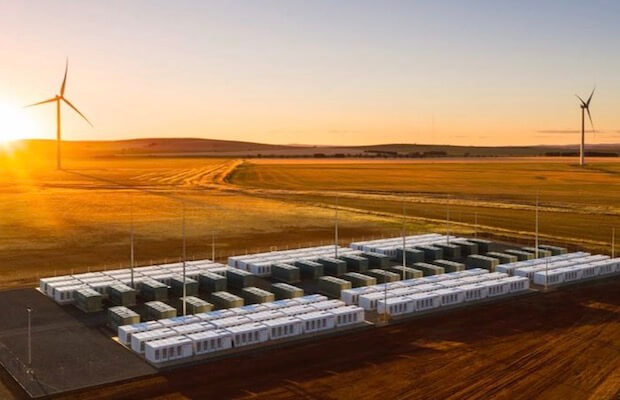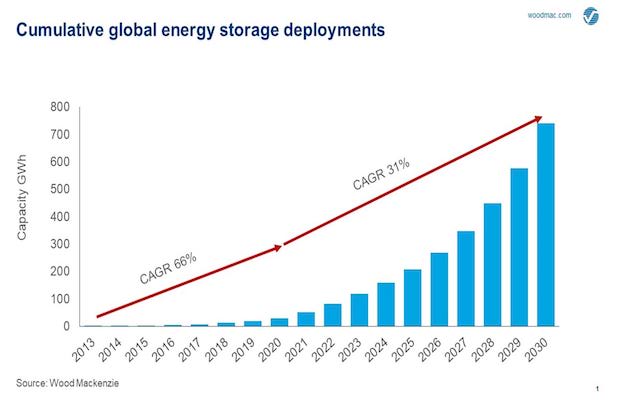
A new report by Wood Mackenzie’s has estimated that the global energy storage capacity additions could grow to reach 741 GWh of cumulative capacity by 2030.
A new report by research agency Wood Mackenzie’s has estimated that the global energy storage capacity additions could grow at a compound annual growth rate (CAGR) of 31 percent, recording 741 gigawatt-hours (GWh) of cumulative capacity by 2030.
The report adds that front-of-the-meter (FTM) will continue to dominate annual deployments and will account for up to 70 percent of annual total capacity additions to the end of the decade.
Rory McCarthy, principal analyst at WoodMac, said that “we note a 17 percent decrease in deployments in 2020, 2 GWh less than our pre-coronavirus outlook. We expect wavering growth in the early 2020s, but growth will likely accelerate in the late 2020s, to enable increased variable renewable penetration and the power market transition.”

The authors believe that energy storage is still a nascent market, a relatively new investment class with underlying risks. And that the stakeholders – whether end-consumers or big-equity investors – are interested in continuing to invest in the sector and do not appear to be hindered by the pandemic and economic recession impacts.
“Investment decisions are likely to be pushed back in some cases, but the general trajectory of the power market transition and the need for energy storage to enable this has not changed,” McCarthy said. “If anything, the transition may be accelerated as governments around the world grapple with how to recover their economies more sustainably than in the past with upside for the energy storage industry.”
The report goes on to add that the US maintained its pole position and will make up over 49 percent or 365 GWh of global cumulative capacity by 2030. Utility resource planning in the US is set to take a front seat for deployments over the coming decade. In the past two years, utility approaches to renewables and particularly storage have shifted seismically, with the majority of utilities dramatically shifting planned resources towards renewables and storage due to cost and state-driven clean-energy goals.
China, coming in second after the US, is also expected to see its cumulative storage capacity grow exponentially. It will account for 21 percent or 153 GWh of global cumulative capacity by the end of the decade. The ancillary service market is the primary revenue stream for the FTM market and continues to attract hybrid storage installations in China from 2020 to 2025. Firming renewables capacity to reduce curtailments is the second most important driver in Australia, China, South Korea and Japan. China launched a policy that requires solar and wind developers to make up the costs for building stable and grid-friendly renewable generation assets.
Energy arbitrage make up additional revenues for storage as more Asia Pacific power markets may be fully liberalised from 2025 to 2030.
Europe’s growth story, on the other hand, is expected to be slower than its global counterparts. The UK and Germany will continue to dominate the FTM market out to 2025. Frequency response auctions remain one of the key revenue streams. France and Italy are also opening up with both capacity and ancillary service markets open or opening. Spain, and the rest of continental Europe is expected to follow, with potential help from the European Commission and its green recovery deal.
Senior analyst Le Xu added that “storage holds the key to strong renewables growth. The question is whether storage can capture stable long-term revenue streams. Low-cost and longer duration storage can increasingly out-compete coal, gas and pumped hydro, enabling higher levels of solar and wind penetration. However, most lithium-ion energy storage systems economically max out at 4 to 6 hours, leaving a gap in the market.”
On September 23, 2020, Elon Musk, Founder and CEO of Tesla made a slew of announcements regarding the future prices of its models, fresh new battery technology, and even new manufacturing breakthroughs, signalling (in his views) a massive change in direction for the Battery and EV category.
One such announcement was when he confirmed that his firm would be removing cobalt use altogether, due to issues around its origin and the conditions in which it is mined, and another new shift away from Graphite, which has been the most stable part of lithium-ion battery chemistry as an anode, over the decades.
Firms have pushed for more Silicon over the years to improve energy density and charging capabilities. Silicon can store nine times more lithium than graphite, a Silicon dominant anode has not happened for various reasons. Tesla claims to have overcome this challenge by removing the graphite entirely and using an elastic, ion-conducting polymer coating as a stabiliser. Other methods have utilised complex and costly designs such as graphene and nanotubes, but Tesla’s method is apparently simpler, cheaper and would even provide a 20 percent boost in range.
If true, this advancement in battery technology alone could be a huge growth factor for the battery industry. Which perhaps could be one breakthrough away from truly expanding at an exponential rate.




























